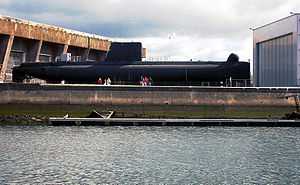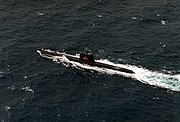Daphné-class submarine
 Daphné-class submarine Flore (S645) | |
| Class overview | |
|---|---|
| Name: | Daphné class |
| Operators: |
|
| Preceded by: | Aréthuse class |
| Succeeded by: | Agosta class |
| Subclasses: | Albacora class |
| In commission: | 1964–2010 |
| General characteristics | |
| Type: | Submarine |
| Displacement: | 860 tonnes surfaced 1,038 tonnes submerged |
| Length: | 57.75 m (189.5 ft) |
| Beam: | 6.74 m (22.1 ft) |
| Draught: | 5.25 m (17.2 ft) |
| Propulsion: | Diesel-electric, two shafts, 1,600 shp |
| Speed: | Submerged: 15 knots (28 km/h) Schnorcheling: 8 knots (15 km/h) |
| Range: | Surfaced: 10,000 nautical miles (18,500 km) at 7 knots (13 km/h) |
| Endurance: | 30 days |
| Test depth: | 300 m (980 ft) |
| Complement: | 6 officers 24 non-commissioned officers |
| Sensors and processing systems: | DRUA 31 radar DUUA 2B sonar |
| Electronic warfare and decoys: | ARUR 10B radar detector |
| Armament: | 12 x 550 mm torpedo tubes (8 bow, 4 stern) 12 torpedoes or missiles |
The Daphné class was a type of diesel-electric patrol submarines built in France between 1958 and 1970 for the French Navy and for export.
History
These submarines were enlarged versions of the Aréthuse class. Eleven were used by France. Boats of this design were sold to several other countries: Pakistan (3), Portugal (4), South Africa (3) and Spain (4). However, two (Eurydice 1970 and Minerve 1968) sank accidentally and brought sales to an end. The cause was eventually considered to have been a faulty snorkel design. The submarines were scrapped in the 1990s and Portugal sold one of its boats to Pakistan. PNS Hangor sank the Indian frigate INS Khukri during the 1971 Indo-Pakistani war. Pakistan has now retired the submarine and is replacing it
Ships
- French Navy
- S641 Daphné - completed 1964 - decommissioned 1989
- S642 Diane - completed 1964 - decommissioned 1989
- S643 Doris - completed 1964 - decommissioned 1994
- S644 Eurydice - completed 1964 - lost in an accident on 4 March 1970
- S645 Flore - completed 1964 - decommissioned 1989
- S646 Galatée - completed 1964 - decommissioned 1991
- S647 Minerve - completed 1964 - lost in an accident on 27 January 1968
- S648 Junon - completed 1966 - decommissioned 1996
- S649 Vénus - completed 1966 - decommissioned 1990
- S650 Psyché - completed 1970 - decommissioned 1996
- S651 Sirène - completed 1970 - decommissioned 1996
- Pakistan Navy
- S131 PNS Hangor - completed 1970 - decommissioned 2006 (now placed in Pakistan Maritime Museum)
- S132 PNS Shushuk - completed 1970 - decommissioned 2006
- S133 PNS Mangro - completed 1970 - decommissioned 2006
- S134 PNS Ghazi (ex Portuguese Cachalote) - acquired 1975 - decommissioned 2006
- Portuguese Navy (Albacora-class submarine)
- S163 Albacora - completed 1967 - decommissioned 2000
- S164 Barracuda - completed 1968 - decommissioned 2010
- S165 Cachalote - completed 1969 - sold to Pakistan 1975
- S166 Delfim - completed 1969 - decommissioned 2005
- South African Navy
- S97 SAS Maria van Riebeeck - renamed SAS Spear - completed 1970 - decommissioned by 2003
- S98 SAS Emily Hobhouse- renamed SAS Umkhonto - completed 1970 - decommissioned by 2003
- S99 SAS Johanna van der Merwe - renamed SAS Assegaai - completed 1971 - decommissioned by 2003 - converted to museum ship[1]
- Spanish Navy (built by Bazan at Cartagena dockyard)
- S61 Delfín - completed 1973 - decommissioned 2003, ship museum at Torrevieja [2]
- S62 Tonina - completed 1973 - decommissioned 2005
- S63 Marsopa - completed 1975 - decommissioned 2006
- S64 Narval - completed 1975 - decommissioned 2003
Image gallery
-
Daphné-class submarine Ghazi (S-134)
-

Psyché
-

Doris
References
External links
![]() Media related to Daphné class submarine at Wikimedia Commons
Media related to Daphné class submarine at Wikimedia Commons
| ||||||||||||||||||||||
